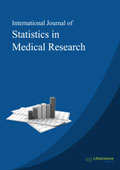ijsmr
Abstract: An Alternative Stratified Cox Model for Correlated Variables in Infant Mortality
|
|
Abstract: Often in epidemiological research, introducing a stratified Cox model can account for the existence of interactions of some inherent factors with some major/noticeable factors. This paper aims at modelling correlated variables in infant mortality with the existence of some inherent factors affecting the infant survival function. A Stratified Cox model is proposed with a view to taking care of multi-factor-level that has interactions with others. This, however, is used as a tool to model infant mortality data from Nigeria Demographic and Health Survey (NDHS) with g-level-factor (Tetanus, Polio and Breastfeeding) having correlations with main factors (Sex, infant Size and Mode of Delivery). Asymptotic properties of partial likelihood estimators of regression parameters are also studied via simulation. The proposed models are tested via data and it shows good fit and performs differently depending on the levels of the interaction of the strata variable Z*. An evidence that the baseline hazard functions and regression coefficients are not the same from stratum to stratum provides a gain in information as against the usage of the Cox model. Simulation result shows that the present method produces better estimates in terms of bias, lower standard errors, and or mean square errors. Keywords: Stratified Cox, Semiparametric model, infant mortality, multifactor-level, confounding variables. |
Abstract: Evaluation and Comparison of Patterns of Maternal Complications Using Generalized Linear Models of Count Data Time Series
|
|
Abstract: Studying patterns of maternal complications is critical before, during and after childbirth. However, there is limited information on comparative trends of different maternal complications, particularly, in a resource-limited setting. In this study we fit six different types of maternal complications namely ante-partum haemorrhage (APH), eclampsia, obstructed labour, post-partum haemorrhage (PPH), ruptured uterus and sepsis to time series generalized linear model. We systematically compare the performance of the model in light of real data by checking its flexibility and serial correlation and the conditional distribution. We then, compute model fitting, assessment and prediction analysis for each maternal complication. Additionally, we provide a comparative review of the results by assessing the effect of intervention 1: basic emergency obstetric and new-born care (BEmONC) and intervention 2: comprehensive emergency obstetric and new-born care (CEmONC) services on trends in maternal complications. Results show that women with APH, eclampsia and obstructed labour at the time of delivery are significantly high. Maternal complication did not statistically vary by counties. The results of count GLM for APH showed presence of Intervention1 (BEmONC) reduces APH by a factor -0.189 (LCI =- 0.298, UCI= -0.0805) while CEmONC was not statistically significance. Similar inference is registered by PPH i.e. Intervention1 (BEmONC) is -0.17 (LCI =-0.258, UCI= - 0.082) while CEmONC remains insignificant. This can be interpreted to mean that public health facilities only require the basic minimum (BEmONC) infrastructure to cub APH and PPH. Mothers with sepsis and eclampsia were significantly more likely to experience maternal and perinatal deaths when delivering at facilities that lack BEmONC. Caregivers, who perform obstetric and maternal care, need be alert of maternal complications associated with PPH and obstructed labour. Introduction of BEmONC and CEmONC packages in maternal and neonatal clinics improved performance of caregivers in reducing maternal and pediatric complications and mortality. Keywords: Maternal complications, Count Data time series, Trends, Goodness-of-fit, Conditional distribution. |
Abstract: Multivariate Analysis of Data on Migraine Treatment
|
|
Abstract: Migraineur constitutes a multidimensional model of health disorder involving a complex combination of genetic, psychological, demographic, enviromental and economic factors. This model provides a framework to describe limitations of an individual functional ability and quality of life, and to aid in the elaboration of more adequate intervention programs for each patient. Our primary objective in this paper is a data-driven profiling of patients. Keywords: Kostecki-Dillon, General dissimilarity coefficient, Cluster analysis, Multi-dimensional scaling. |
Abstract: Troubles of Atrial Mechanical Recovery after Electrical Cardioversion in Patients with Persistent or Long-Lasting Persistent Atrial Fibrillation
|
|
Abstract: Background: In the present retrospective cohort study we have evaluated the missed or delayed atrial mechanical recovery in a population of patients with persistent or long-lasting persistent atrial fibrillation (AF) who achieved restoration of sinus rhythm on the ECG by electrical cardioversion (ECV). Methods: The endpoint of our study was the failure to recover the normal mechanics of the left atrium. Inclusion criterion was the persistent or long-lasting persistent AF successfully treated by means of ECV, provided that a pertinent documentation was made available, comprising ECG, conventional 2D echo-color-Doppler and speckle tracking echocardiography(STE) evaluation, with also a STE assessment of the atria at the days 1, 30 and 90 from the ECV freely available within the clinical record of the patient. Keywords: Atrial fibrillation, electrical cardioversion, atrial mechanical recovery, speckle tracking echocardiography, outcome. |






















